Golf isn’t thought of as a dynamic sport to photograph, because the action isn’t fast and there are very strict rules on photographing PGA events. One would be quite surprised at how much opportunity exists to capture raw emotion, beautiful surroundings, and athleticism to the photographer who is willing to seek out the possibilities.
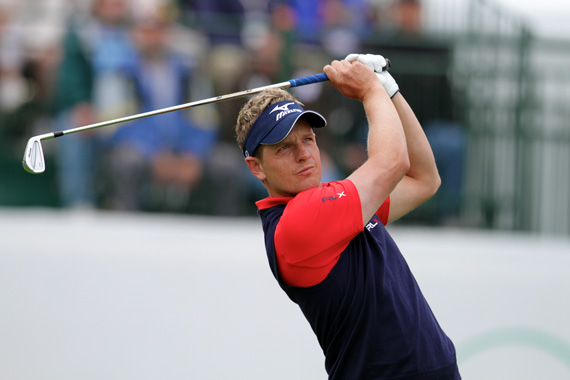
Luke Donald #12 Round 2 BMW Championship Captured by Rob Hayashida
Go Wide and Capture all the Action
PGA and LPGA golf tournaments are hosted at some of the most beautiful golf courses, which give the photographer a great canvas to shoot the action going on and off the course. The use of a wide-angle lens is a must for getting everything in perspective: the putting green, the golfers, the crowd, and the surrounding landscape. On select holes on the golf course (1st tee, 9th green, and 18th green) shooting from the highest point on the grandstands provides the best perspective to capture all the action. I like to use a 17–40mm lens at f/5.6 and higher for a deep depth of field. The larger the aperture the sharper your images will be.
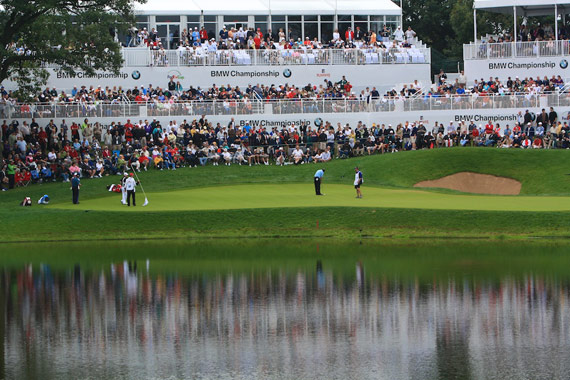
Looking at 18 from Pond Cog Hill
Freeze the Action
No matter what sport you photograph, you always want to be able to freeze the action. The golf swing of professional golfers on the PGA Tour average around 105–110 MPH, and freezing the action of a golf swing requires a fast shutter speed. Set the shooting mode on your camera to TV (Shutter Priority on Canon bodies), set the shutter speed to a minimum of 1/500 of second, and change your drive mode to High-Speed Continuous Shooting. This way you can shoot multiple shot bursts by holding down the shutter button. I typically set my shutter speed to 1/2000 to 1/2500 of second so I can stop the action of a golf swing and freeze the golf ball. Every DSLR has its own frame rate and capture rate and will vary by the shutter speed, picture style, ISO speed, type of memory card, lens, and light.
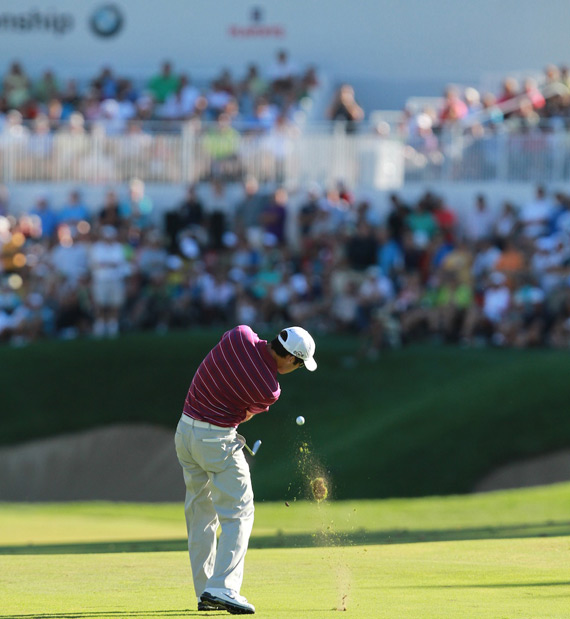
Paul Casey Approach on the 18th
Zoom in on the Action
Golf is the only sport where you’re not allowed to photograph a player during their backswing. That’s where the use of a super-telephoto lens comes in handy for helping catch the action from distance and without worrying about distracting the golfer with the sound of the shutter. Shooting with 300mm f/2.8L IS or 400mm f/2.8L IS can prove to be quite challenging and daunting because of the weight of the lens (weighing anywhere from 6 to 11 pounds), but also where to position yourself on the golf course to get your desired shot. If you’re going to shoot with either of these super-telephoto lenses, you need to support them on a heavy duty monopod.
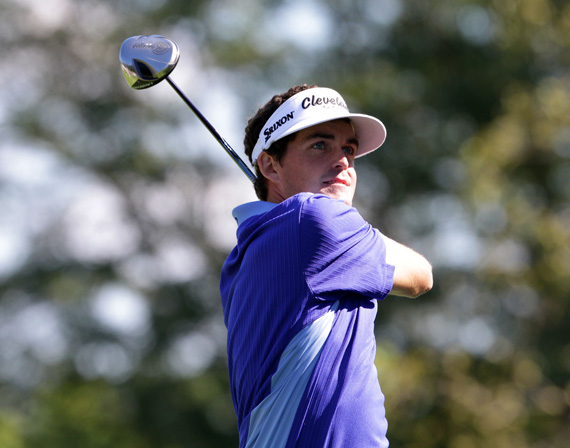
Keegan Bradley Drive on 11 Round 3 BMW Championship
Set your camera’s Autofocus to AI Servo to continuously refocus the lens on the golfer during their downswing and through the finish of their swing. Where you position yourself can be challenging at first if you’ve never shot with a fixed focal length zoom lens. Initially this will require a little experimentation depending on the type of shot you desire and the composition you’re trying to achieve. Shoot close ups with a shallow depth of field at f/2.8 (horizontal position of the camera) to get great bokeh of the golfer holding their finish at the tee. For full body pictures (vertical position of the camera) of their approach shots to the green or putting, depending on the background, use an aperture of f/2.8 and higher.
Get Creative…Tell a Story
Once you’ve gotten the standard shots, it’s time to get creative. Take photos that show the emotion of players who miss a crucial shot, golfers interacting with their fans when signing autographs, volunteers working the event, etc. Anything that can give people a look behind the scenes of what happens at golf events and tells a story. For these types of shots, use a telephoto lens (70–200mm) to capture the unexpected from afar.
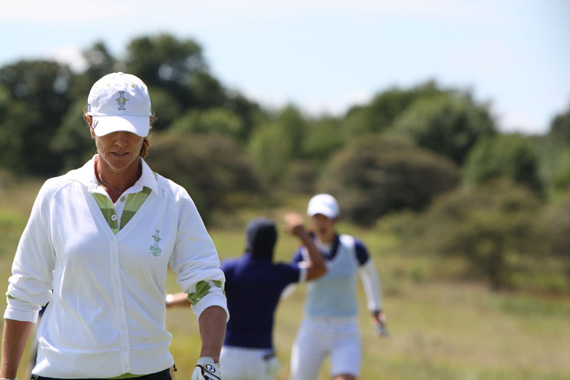
At the Solheim Cup, Kim and Wie Celebrate
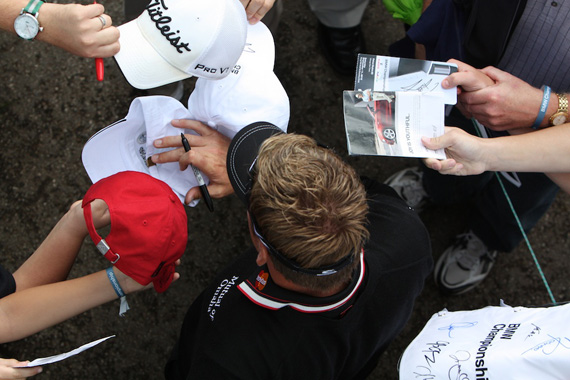
Ian Poulter Signs Autographs after a Successful Game
Recommended Settings
Since golf tournaments are held outdoors, the weather conditions can vary (bright and sunny, overcast, and rainy). On overcast and rainy days you’ll want to increase your ISO to 400 or higher depending on the conditions. On bright sunny days, an ISO of 100. Set the camera to High-Speed Continuous Shooting, TV Mode (Shutter Priority), shutter speed of 1/2000 of a second, and autofocus to AI Servo to continuously refocus the lens.
Recommended Equipment
When shooting a professional or amateur golf event, you need a minimum of two camera bodies, ideally three. I recommend either a camera with a high frames per second rate (at least 8 to 10 frames per second). I also recommend a super-telephoto lens like a 300mm or 400mm and heavy duty monopod. For my second camera body, I use a 70–200mm telephoto lens 70-200mm for those in between focal length shots that the fixed super-telephoto is too much. On the third camera body, I either go with a 17–40mm or 16–35mm my wide angle lens.
Since golf tournaments happen outdoors, always pack rain covers to protect your lens and camera bodies in the event it starts raining. And since you’ll be carrying all this heavy equipment across the golf course over the course of a day, wear comfortable trail running shoes.
Marketing Your Photos
A great way to market your photos and potentially sell them is to set up a blog on WordPress.com. I have a blog that I run where I feature photos from the events I cover, and I also share my photos on both Facebook and Twitter. Another great way to market your photos is on Pinterest. Finally, there is the Flickr Collection on Getty Images, where you can submit and license your work to Getty Images.
Additional Thoughts
Most people don’t have the opportunity to photograph PGA and LPGA, because of the credentialing requirements, but you can still photograph local golf club and amateur tournaments. Golf is a fun sport to photograph because you can witness athleticism and raw emotion in some of the most tranquil and beautiful settings. Composition, shutter speed, and timing are most important in photographing golf.
About the Author:
Rob Hayashida is a freelance sports photographer based in Chicago, IL specializing in shooting PGA and LPGA events. Portfolio: http://robhayashida.viewbook.com. When not shooting golf, Rob enjoys working on Sandbox8.com, one of the top golf news and equipment websites.
Go to full article: Golf Photography Tips
What are your thoughts on this article? Join the discussion on Facebook
Article from: PictureCorrect